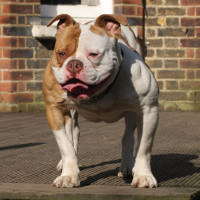Appearance of the American Bull-Aussie
|
| These cute hybrid dogs will adopt the physical characteristics of both parent breeds. They will have a long tail but short, floppy ears. The American Bulldog has a powerful, robust build with a large head and strong jaws. They have a broad, deep chest with a strong neck that tapers from the shoulders to the head, which is large, broad and square. The eyes are rounded and the stop is defined. Their muzzle is square and broad, and will have either a scissor bite or a uniform pincer bite. The front flap of cropped, pink or half-pricked ears can all be seen on this breed. The straight legs are strongly boned, and the hind legs will be muscular, broad and thick. The tapered tail is low. This dog's other parent, the Australian Shepherd, is a medium-sized dog that is slightly longer than it is tall. They have a deep chest and stand upright, with a muzzle the same length as the top of their head. Their medium-sized oval eyes, like their coats, can come in a variety of colors. Triangular ears are set high and erect on top of their heads, and these dogs will have manes around their necks and feathers on the backs of their legs. It's hard to know what percentage of each parent your American Bull-Aussie will have, but they'll be a combination of both breeds. |
Temperament of the American Bull-Aussie
|
| This specific crossbreed is intelligent, loyal and protective of its family. They are intelligent and will be relatively easy to train. Although alert, these dogs will not be good as watchdogs as they are not big barkers. They are playful and calm, and get on very well with children. The American Bulldog is known for being a loyal, non-hostile dog that protects its family and loves children. To prevent them from becoming reserved towards strangers or aggressive with other dogs, these dogs will need appropriate socialization and training. Australian Shepherds are courageous, devoted and easy to get along with. They're also great with children, and with their high intelligence, they're also easy to train. These dogs are calm around their families but devoted and aggressive when doing their job, which is herding livestock. Although they are not generally aggressive towards other dogs, they still need to be socialized and trained early in life, as do all breeds. It's impossible to know for sure what personality the American Bull-Aussie will develop, but it's safe to assume that it will be similar to that of its parents. |
Needs and activities of the American Bull-Aussie
|
| The American Bulldog will need plenty of exercise and stimulation, both mental and physical, or they may become difficult to manage. The Australian Shepherd could also become destructive and upset if not sufficiently active. While all dogs are different and the exact amount of exercise depends on the individual, be prepared to devote at least 45 minutes to an hour of exercise for your American Bull-Aussie. |
Maintenance of the American Bull-Aussie
|
| The American Bull-Aussie is a dog with a moderate shedding level and should therefore be brushed about once a week. While grooming, use a grooming glove for best results. To reduce the risk of developing infection or other problems, your dog should have his ears cleaned and checked every week. To keep your dog's teeth clean and healthy, teeth brushing should be carried out three times a week or, better still, every day. In terms of nail trimming, this hybrid breed should receive the same care as all other dogs. This means that they should be trimmed once or twice a month, unless they wear naturally, in which case less often might suffice. You should start playing with your dog's feet and mouth at an early age to make grooming a pleasurable experience as he grows. |









 English (United Kingdom)
English (United Kingdom)